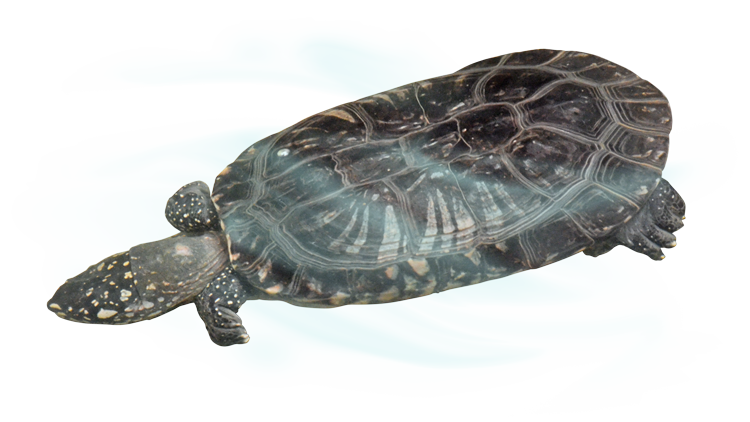
Geoclemys hamiltonii (Gray, 1830)
斑紋で水辺に溶け込む希少なカメ
A Rare Turtle Blending into the Waters with Its Patterns
甲長は約30cmで、インド北部、ネパール、パキスタン、バングラデシュなど南アジアに広く分布しています。特にインダス川、ガンジス川、ブラマプトラ川などの主要河川でよく見られ、水辺の環境に適応しています。背甲はやや隆起しており、椎甲板や肋甲板の上には三列のキール(縦方向の隆起)が並び、個体の保護と泳ぎやすさに役立っています。
色彩は黒を基調とし、幼体や若い個体では白い斑紋が目立ちます。この斑紋は水中や水際の光と影、泥や落ち葉などの自然環境に溶け込み、ワニや鳥類、哺乳類などの捕食者から身を守る迷彩効果を発揮します。成長とともに斑紋は薄れ、成体ではより落ち着いた黒色が目立つようになります。
系統的にはバタグールガメと近縁で、約2,000〜2,500万年前に分岐したと考えられています。「河川型大型イシガメ」への進化において重要な位置を占める種であることも分かっており、南アジアの淡水生態系における生態的役割も大きいとされています。
ハミルトンガメの名前は、スコットランドの医師で博物学者であったフランシス・ブキャナン=ハミルトン(Francis Buchanan-Hamilton)に由来します。彼は19世紀初頭にインド亜大陸を訪れ、現地の動植物を詳細に記録したことで知られています。
The carapace length reaches about 30 cm, and this species is widely distributed across South Asia, including northern India, Nepal, Pakistan, and Bangladesh. It is particularly found in major rivers such as the Indus, Ganges, and Brahmaputra, thriving in freshwater environments. The carapace is slightly domed, with three longitudinal keels running along the vertebral and costal scutes, which aid in protection and swimming.
Its coloration is predominantly black, with young individuals displaying prominent white patterns. These patterns help them blend into the interplay of light and shadow in and around water, as well as into mud and fallen leaves, providing camouflage against predators such as crocodiles, birds, and mammals. As they mature, the patterns fade, and the adults become mostly black.
Phylogenetically, this species is closely related to the Northern River Terrapin (Batagur) and is believed to have diverged approximately 20–25 million years ago. It plays a key role in the evolution of large riverine turtles and is an important part of South Asian freshwater ecosystems.
The name of this turtle honors Francis Buchanan-Hamilton, a Scottish physician and naturalist who visited the Indian subcontinent in the early 19th century and meticulously documented its flora and fauna.
参考文献
札幌市円山動物園 | 動物紹介 | ハミルトンガメ 2025年10月20日閲覧